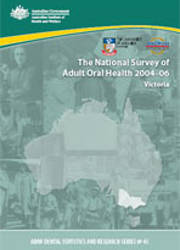Summary
Overview of results
This report describes levels of oral health in the adult population of Victoria at the beginning of the twenty-first century. The findings are from the 2004–06 National Survey of Adult Oral Health (NSAOH). In Victoria, 2,667 people were interviewed and 1,181 people were dentally examined for the survey. This report presents percentages and means for 30 oral health indicators in tables that compare three age groups and classify people according to five sociodemographic characteristics: sex, residential locality, socioeconomic status of residential postcode, government health card status, and dental insurance status.
Oral health status
- 8.0% of people had no natural teeth and among dentate people, an average of 4.3 teeth per person were missing. These and two other indicators of tooth loss were associated with all sociodemographic characteristics other than sex.
- 24.0% of people had untreated dental decay and an average of 12.8 teeth per person were decayed, missing or filled. There was relatively little variation among sociodemographic groups in indicators of dental decay experience.
- 23.7% of people had inflamed gums and 26.4% had moderate or severe gum disease. There was relatively little variation among sociodemographic groups in indicators of dental decay experience.
Oral health care
- 59.7% of people had visited a dentist within the preceding 12 months, and 52.8% said they usually did so. Indicators of dental attendance varied according to residential locality, socioeconomic status of residential postcode, government health card status and dental insurance status.
- 80.1% of people had a dentist that they usually attended, although 29.2% said that they avoided or delayed dental care due to its cost. Barriers to dental care were associated with low socioeconomic status, having a government health care card and a lack of dental insurance.
Oral health perceptions
- 16.9% of people said they had avoided some foods due to dental problems, and 16.0% had experienced toothache, in the preceding 12 months. Perceptions of poor oral health were associated with having a government health card and a lack of dental insurance.
- 31.8% of people felt they needed an extraction or filling, although only 7.9% said they needed dentures. Socioeconomic status and dental insurance status were associated with perceived treatment needs.
Age-standardised analysis revealed that government health cardholders had poorer outcomes for 18 of the 29 indicators reported, while the uninsured had poorer outcomes for 21 of the 30 indicators.
Preliminary material: Abbreviations; Symbols; Acknowledgments
Overview of results
- Oral health status
- Oral health care
- Oral health perceptions
-
Introduction
- Purpose and organisation of this report
- Background to the survey
- Aspects of oral health and dental care relevant to the National Oral Health Plan
-
Methods
- Study population and sampling
- Sampled postcodes
- Computer-assisted telephone interview
- Oral epidemiological examination
- Period of data collection
- Ethical conduct of research
- Target sample size
- Participation in the survey
- Data analysis
- Distribution of sociodemographic and dental access characteristics
-
Oral health status
- Complete tooth loss
- Inadequate natural dentition among dentate people
- Denture wearing by dentate people
- Average number of teeth per person missing due to pathology
- Prevalence of untreated coronal decay
- Percentage of people with untreated root decay
- Percentage of people with one or more filled teeth
- Average number of decayed, missing and filled teeth per person
- Prevalence of moderate or severe periodontitis
- Prevalence of deep pocket depth
- Prevalence of 4+ mm clinical attachment loss
- Prevalence of gingival inflammation
-
Oral health care
- People's most recent dental visit
- Attendance at private dental practice
- Payments by patients for dental care
- Government-subsidised dental care in private sector
- People's usual pattern of dental visits
- Usual attendance at the same dentist
- Usual dental attendance for a check-up
- Dental care avoided or delayed due to cost
- Recommended dental treatment foregone due to cost
- Difficulty paying a $100 dental bill
- Percentage of people avoiding foods due to dental problems
-
Oral health perceptions
- Percentage of people rating their oral health as fair or poor
- Percentage of people experiencing toothache
- Percentage of people experiencing orofacial pain
- Perceived need for dentures
- Perceived need for dental extraction or filling
- Perceived need for a dental check-up
- Perceived urgency of dental treatment nee
- Age-standardised comparison between government health cardholders and non-health cardholders
- Age-standardised comparison between the dentally insured and the uninsured
Appendix
- Sample counts
End matter: Glossary; References; List of tables



